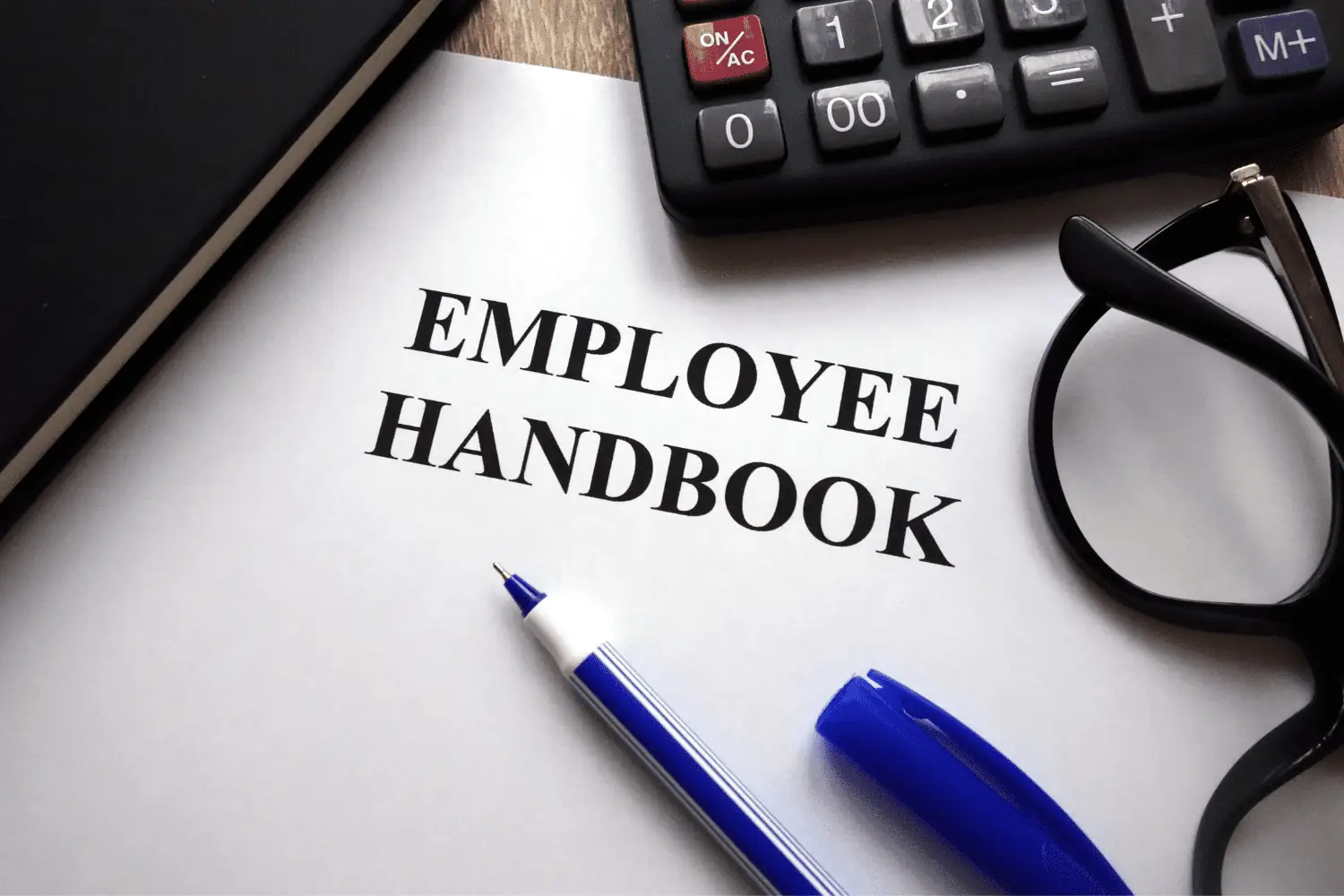5 Best Practices for Updating an Employee Handbook in 2021
August 16th, 2021

Updating your employee handbook yearly is critical for HR compliance, but in 2021 it’s imperative. The pandemic has brought on a myriad of changes in the workplace: safety concerns, remote work, and hybrid work models, as well as state-mandated PTO and sick time requirements for employee policies. To avoid costly lawsuits due to compliance and maintain workplace safety, employers should utilize this guide from MP’s HR services team to update their staff handbook.
1. Develop or update a telework policy for your employee handbook.
Employers who switch to a remote or hybrid work environment post-pandemic may not have a clear or comprehensive telework policy in place. Especially if employees will be working more remotely than before the pandemic, this kind of employee policy will be vital for success and protecting the organization. (Note that MP’s HR consulting team will happily assist with developing a solid telework policy.) A clear telework policy will reduce or eliminate surprises and miscommunications. The policy must include expectations for:
- Tasks that can or cannot be completed remotely
- Delivering work
- Reporting hours worked, especially for non-exempt employees (who must be paid for all time worked, per the Federal Labor Standards Act (FLSA)
- Meetings
- Availability and procedures for asking and answering questions between colleagues and managers
- General hours or schedules
- Technology (software, laptops, headsets, other hardware, etc.) and resources employees must utilize for job duties
2. Update sick leave and PTO policies in your employee handbook.
Employers must update their sick leave and PTO policies in a few ways. Firstly, to reduce the spread of COVID or the possibility of COVID infections in the workplace, employers should encourage sick employees to work from home or call out sick if they are symptomatic, were exposed to COVID (and aren’t vaccinated), or are awaiting the results of a COVID test. Another strategy is to increase PTO or sick leave to encourage employees to take time off when they may have COVID or have been exposed to it. Lastly, employers must also consider state and local laws requiring paid sick leave for employees who are:
- Getting vaccinated
- Experiencing vaccine side effects
- Have COVID
- Waiting for a COVID test result
- Taking care of a family member due to COVID-related circumstances (such as a school closing due to a COVID outbreak)
- Other circumstances
3. Develop and update COVID safety policies for your handbook.
Every employer will vary on their COVID safety policies based on their location, how they serve clients and customers, and how much their team will be working remotely. For employers in states with low vaccination rates and high COVID cases, it may make sense to require masking, even from vaccinated employees. For states with high vaccination rates and low COVID cases, this may not apply. These are some strategies for COVID safety and reducing the spread of the disease that a policy might address:
- Masking
- Social distancing
- Banning or reducing the number of visitors
- Hygiene and handwashing
- Travel, especially to high-risk areas (and potential quarantine requirements afterward)
- Sanitizing the office or workplace
- Staggering breaks and lunches to reduce the number of employees gathered in one place
- Ability to leave and enter the premises during the workday
- Movement between different areas of the workplace
- Receiving personal packages or mail at work
Because COVID safety policies may need to change over time, employers should include language like “until further notice” or “until employees are notified otherwise.” This language will allow employers to adapt policies as needed to changing regulations, laws, and the rise or fall in COVID cases and vaccinations.
4. Avoid COVID vaccination policies.
Many employers are considering requiring COVID vaccination, but HR compliance experts strongly encourage avoiding setting policies regarding vaccination. To reduce legal exposure and risk, employers that aren’t able to make a business case for requiring vaccination shouldn’t attempt to require vaccination. Employers that make a solid business case for requiring COVID vaccination will usually be hospitals or long-term care facilities, where employees are frequently in contact with medically vulnerable people. Organizations and businesses outside the healthcare industry are highly unlikely to develop a legally justifiable COVID vaccination policy. If they have one in their staff manuals, they should retract it immediately. These employers should encourage COVID vaccination. They may share information, post signs and share messages encouraging it, and provide time off for vaccination. (Note that incentivizing COVID vaccination may trigger Americans with Disabilities Act (ADA) compliance issues, so employers may want to avoid it.)
5. Compose a disaster or contingency policy.
A disaster or contingency plan will be helpful during the pandemic and beyond. Employers should clearly articulate what employees and managers should do if COVID cases or numbers rise to a dangerous height or if there are governmental orders to stay home or reduce business hours. This policy might include options for remote work (especially who is or is not able to do so), sanitization of the workplace, and COVID testing. The policy should share the steps that employers will take if there is a possible case of COVID or COVID exposure in the workplace. Another consideration is how key responsibilities will be covered if workers are sick or unable to work. Lastly, the policy should denote one person (and ideally a backup or two) who will be the point for all communications in an emergency. It should indicate how that person will be sharing information, be it via a phone call, the company intranet, email, etc.
Employers may want to use their COVID emergency plan as a blueprint for a generic emergency plan. Having one in place, especially before an emergency, will be particularly impactful for any workplace. These kinds of policies will not only help keep employees safe, they’ll also reduce legal risk for an employer. As mentioned above, the COVID policy should be written with room to adapt to ever-changing circumstances. Employers may utilize language like “until further notice” to build in that flexibility.
Recent Posts
- Planning for 2026: 5 HR Decisions You Need to Make Before Year-End
- Brokers 2026 Planning Guide: How to Make Your Clients Stick Around
- Part 1 – The 2025 HR Compliance Debrief: The Big Shifts Employers Can’t Ignore
- Part 3 – Turning ACA Data into Strategy: How HR Teams Can Use Compliance Insights to Drive Smarter Benefits Decisions in 2025
- CPA Year-End Checklist: How the Right Payroll Partner Protects Your Client Advisory Practice
Categories
- ACA (10)
- AI (6)
- BizFeed (6)
- Business Strategy (122)
- COBRA (5)
- Compliance (255)
- COVID-19 (92)
- Diversity (12)
- eBooks (19)
- Employee Engagement (33)
- Employee Handbooks (24)
- ERTC (29)
- FFCRA (7)
- HR (314)
- MP Insider (13)
- Payroll (175)
- PFML (9)
- PPP (24)
- PTO (5)
- Recruiting (54)
- Remote Work (39)
- Return to Work (32)
- Unemployment (1)
- Wellness (22)
Archives
- December 2025
- November 2025
- October 2025
- September 2025
- August 2025
- July 2025
- June 2025
- May 2025
- April 2025
- March 2025
- February 2025
- January 2025
- December 2024
- November 2024
- October 2024
- September 2024
- August 2024
- July 2024
- June 2024
- May 2024
- April 2024
- March 2024
- February 2024
- January 2024
- December 2023
- November 2023
- October 2023
- July 2023
- June 2023
- May 2023
- April 2023
- March 2023
- January 2023
- December 2022
- October 2022
- September 2022
- August 2022
- July 2022
- June 2022
- May 2022
- April 2022
- March 2022
- February 2022
- January 2022
- December 2021
- November 2021
- October 2021
- September 2021
- August 2021
- July 2021
- June 2021
- May 2021
- April 2021
- March 2021
- February 2021
- January 2021
- December 2020
- November 2020
- October 2020
- September 2020
- August 2020
- July 2020
- June 2020
- May 2020
- April 2020
- March 2020



